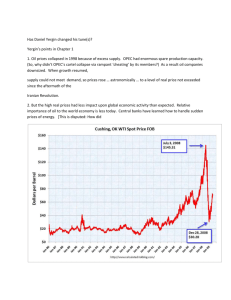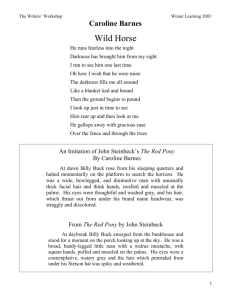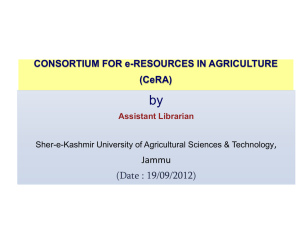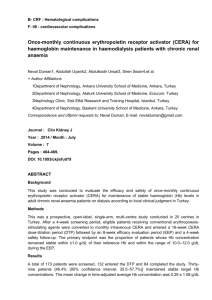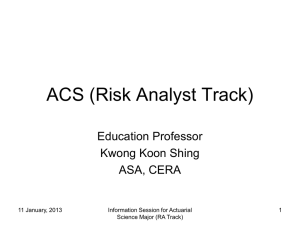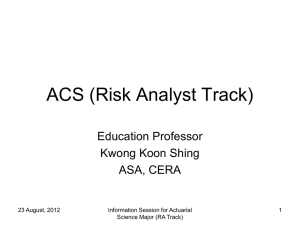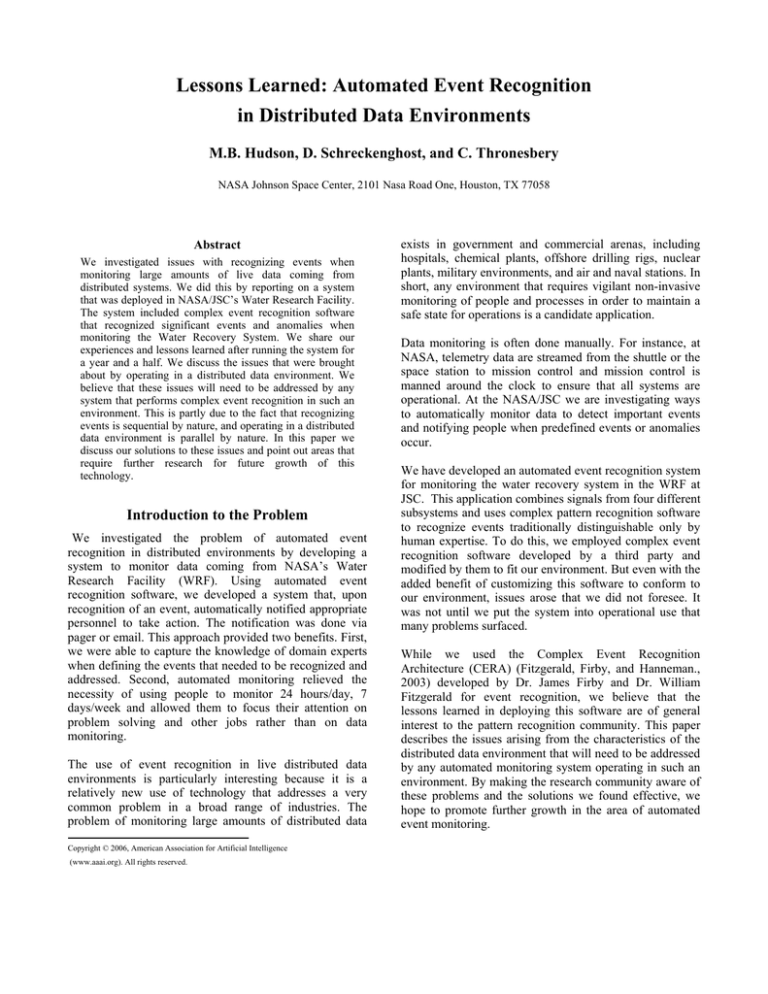
Lessons Learned: Automated Event Recognition
in Distributed Data Environments
M.B. Hudson, D. Schreckenghost, and C. Thronesbery
NASA Johnson Space Center, 2101 Nasa Road One, Houston, TX 77058
Abstract
We investigated issues with recognizing events when
monitoring large amounts of live data coming from
distributed systems. We did this by reporting on a system
that was deployed in NASA/JSC’s Water Research Facility.
The system included complex event recognition software
that recognized significant events and anomalies when
monitoring the Water Recovery System. We share our
experiences and lessons learned after running the system for
a year and a half. We discuss the issues that were brought
about by operating in a distributed data environment. We
believe that these issues will need to be addressed by any
system that performs complex event recognition in such an
environment. This is partly due to the fact that recognizing
events is sequential by nature, and operating in a distributed
data environment is parallel by nature. In this paper we
discuss our solutions to these issues and point out areas that
require further research for future growth of this
technology.
Introduction to the Problem
1
We investigated the problem of automated event
recognition in distributed environments by developing a
system to monitor data coming from NASA’s Water
Research Facility (WRF). Using automated event
recognition software, we developed a system that, upon
recognition of an event, automatically notified appropriate
personnel to take action. The notification was done via
pager or email. This approach provided two benefits. First,
we were able to capture the knowledge of domain experts
when defining the events that needed to be recognized and
addressed. Second, automated monitoring relieved the
necessity of using people to monitor 24 hours/day, 7
days/week and allowed them to focus their attention on
problem solving and other jobs rather than on data
monitoring.
The use of event recognition in live distributed
environments is particularly interesting because it
relatively new use of technology that addresses a
common problem in a broad range of industries.
problem of monitoring large amounts of distributed
Copyright © 2006, American Association for Artificial Intelligence
(www.aaai.org). All rights reserved.
data
is a
very
The
data
exists in government and commercial arenas, including
hospitals, chemical plants, offshore drilling rigs, nuclear
plants, military environments, and air and naval stations. In
short, any environment that requires vigilant non-invasive
monitoring of people and processes in order to maintain a
safe state for operations is a candidate application.
Data monitoring is often done manually. For instance, at
NASA, telemetry data are streamed from the shuttle or the
space station to mission control and mission control is
manned around the clock to ensure that all systems are
operational. At the NASA/JSC we are investigating ways
to automatically monitor data to detect important events
and notifying people when predefined events or anomalies
occur.
We have developed an automated event recognition system
for monitoring the water recovery system in the WRF at
JSC. This application combines signals from four different
subsystems and uses complex pattern recognition software
to recognize events traditionally distinguishable only by
human expertise. To do this, we employed complex event
recognition software developed by a third party and
modified by them to fit our environment. But even with the
added benefit of customizing this software to conform to
our environment, issues arose that we did not foresee. It
was not until we put the system into operational use that
many problems surfaced.
While we used the Complex Event Recognition
Architecture (CERA) (Fitzgerald, Firby, and Hanneman.,
2003) developed by Dr. James Firby and Dr. William
Fitzgerald for event recognition, we believe that the
lessons learned in deploying this software are of general
interest to the pattern recognition community. This paper
describes the issues arising from the characteristics of the
distributed data environment that will need to be addressed
by any automated monitoring system operating in such an
environment. By making the research community aware of
these problems and the solutions we found effective, we
hope to promote further growth in the area of automated
event monitoring.
•
Application – Detecting Autonomous Control
Events
We used CERA to provide the event recognition capability
in the Water Research Facility at NASA/JSC. The WRF is
used to evaluate new hardware for purifying water (called
water recovery). The Water Recovery System (WRS) is an
example of such hardware tested in the WRF. The WRS
consists of four systems: a biological water processor
(PPBWP), a reverse osmosis system (RO), an air
evaporation system (AES), and a post-processing system
(PPS). The WRS is operated by autonomous control
software (Bonasso, et al., 2003). Control engineers are
responsible to keep an eye on the autonomous controller
and intervene should problems arise. Thus, control
engineers look for events indicating anomalous conditions
in the WRS, such as a shutdown of one or more of the
systems, an unsuccessful slough (which is supposed to
unclog a filter), or a loss of communications with other
systems. The Distributed Collaboration and Interaction
(DCI) System was deployed in the WRF to assist control
engineers in interacting with the automated WRS
(Schreckenghost, et al., 2005). Complex event detection
software (i.e., CERA) was deployed as part of the DCI
system. Recognizers for events of interest to control
engineers were defined using the CERA event definition
language. CERA monitored data from the WRS and
compared it to these definitions. When a predefined event
of interest occurred, CERA exported the event to the DCI
agent system, which notified the responsible control
engineers.
We deployed the DCI System January 28, 2004. It
supported testing in the WRF until August 30, 2005.
During much of that time, CERA successfully recognized
the predefined events. The appropriate control engineers
were automatically notified by pager, email or fax when a
predefined event occurred. The event was sent and
supporting data were made available so that the user could
quickly assess the situation and determine what was
happening in the WRF. This allowed the engineers to
spend most of their time working on other projects,
knowing that if anything important happened they would
be alerted immediately. The DCI Event Detection System
based on CERA provided 24 hour/day, 7 day/week
monitoring without requiring human presence in the WRF
to do the monitoring.
CERA patterns are defined in event recognizers. A user
describes an event to be captured by defining a recognizer
for that event. A recognizer is a pattern of sub-events and a
clause telling what actions to take when the event is
recognized. The pattern consists of a list of sub-events
connected by a relation. CERA supports the following
relations:
•
•
•
•
•
ALL – all signals must be seen for the event to be
recognized
ONE-OF – only one signal in the group must be
seen for the event to be recognized
IN-ORDER – a sequence of signals must be seen
for the event to be recognized.
WITHIN – a sequence of signals must be seen
within a specified time period for the event to be
recognized
WITHOUT – a period of time must pass without
a specified signal being seen for the event to be
recognized
James Allen’s 13 Interval Relations (Allen, 1983)
– an event can be described using any of James
Allen’s definitions given two signals.
Events are signaled when the pattern is observed. For
example, a WRS-Shutdown is an event that can be
described by the successful shutdown of its four subsystems. The recognizer for a WRS Shutdown might look
like this:
(define-recognizer WRS-Shutdown
(pattern ‘(ALL
(PPS-Shutdown-complete)
(PPBWP-Shutdown-complete)
(RO-Shutdown-complete)
(AES-Shutdown-complete)))
(on-complete
(Signal ‘(WRS-Shutdown complete)start end)))
The start time and end time of the signal is calculated from
the start and end times of events in the pattern.
The patterns can be hierarchical, that is, there can be
relations nested within the relation. Sub-events are
modeled as separate recognizers that send a signal when
they complete. These signals can be used by a higher level
recognizer. For example, PPS-Shutdown might be defined
like this:
(define-recognizer PPS-Shutdown
(pattern ‘(In-Order
(Air-and-water-flow halted)
(UV-lamps off)
(Decreasing-water-pressure)))
(on-complete)
(Signal ‘(PPS-Shutdown-complete) start end)))
When CERA receives the signals showing all three subevents in the PPS-Shutdown pattern have completed, the
recognizer completes and it issues a signal “PPS-Shutdown
complete”. This signal satisfies one of the steps in the
WRS-Shutdown recognizer. This is how low level
recognizers can be linked to higher level recognizers to
form a hierarchy of events.
The System Architecture
Controlled
Water
Recovery
System
Hardware
commands
data
Controls
Software
data
Complex Event
Recognition
Architecture (CERA)
Schematic
Data Display
& Logger
When CERA received a set data values in a single batch, it
would process them sequentially rather than as a batch of
simultaneous values. Within a single twenty second
interval, it would be possible for a sensor value (pressure
reading) to exceed a critical value and for a resulting
control to respond (turn off a pump). The batching of data
would cause these two events to appear as simultaneous
events. Unfortunately, the serial processing of individual
data values by CERA could occasionally cause the
ordering of these events to be reversed. If the data
representing the pump command appeared higher in the list
of data values in the batch, then it would appear that the
pump was commanded before the pressure reached critical
value.
events
data
(with timestamps
from logging
computer)
Data
Log
During the year and a half that the system was in use in the
WRF we encountered a number of issues related to the
handling of data and the modeling of events by the event
recognition software. We describe these issues and how
we solved them for the WRF application in the next
sections.
Data Handling Issues
Figure 1. Architecture of Distributed Software System
Supporting Event Detection for the WRS
The architecture of the distributed software system
supporting event detection is shown in Figure 1. The
controls software had the only direct link to the controlled
water recovery system hardware. The low-level controls
that provided data to both CERA and to the logging
software did not have easy access to the current time of
day, so timestamps were not affixed to the data until it
reached CERA and the logging software. Since these two
software processes were running on separate computers,
there was an occasional mismatch of system time affixed
to the data. This became a problem when a situation
captured by CERA was displayed with CERA timestamps
and then low level data plots were displayed from the
logged data (with logger timestamps) to illustrate to the
end user precisely what CERA had seen. When times
were out of synch on the two computers, CERA could
appear either very sluggish or prescient. We had an
alternate, test-harness mode for running CERA directly
from the data logs rather than from the live data directly
from the controls software. In this test-harness mode,
CERA recognition times were less perplexing.
In the architecture illustrated in Figure 1, the low-level
controls software would bundle the data into batches and
publish a complete batch of data every twenty seconds.
Any change that took place during the last twenty seconds
would be reflected in the new batch of data. On the
receiving end of this batch of data, any changes must be
considered to have been simultaneous. However, CERA
was built to consider incoming data values sequentially.
The first set of issues that need to be addressed arise from
the fact that event recognition software must collect and
process data from multiple, distributed data sources (such
as the water recovery subsystems described above).
Because of this, timing issues may arise - not only in the
discrepancies in clock times among the multiple systems,
but also in the lag time between the time the data was
sampled and the time the data are processed. There is also
the potential of a bottleneck when sampling data at too
high a rate or losing information when sampling data at too
low a rate.
Issue #1: Multiple Signals Same Timestamp
In distributed systems many data items are sampled at the
same time. Therefore, event recognition software that
processes data signals one at a time can introduce an
artificial ordering on the data. We need to be able to
process a group of multiple signals in the data queue that
were sampled at the same time (which we call a
timestamp), as if they were a single signal.
We encountered this problem using CERA, which assumes
one signal per timestamp. This is due to the fact that the
software evolved from the world of natural language
processing where there is no notion of time stamped data.
Instead, words are parsed in the sequence in which they
occur. Although timing constraints were added to the event
recognition software, they serve primarily to keep track of
the start and finish time for each event. Timestamps for the
start and finish of sub events are propagated to determine
the start and finish of parent events.
Solution for the WRF Application: We had to be careful
in how we created our recognizers to avoid this problem.
Often we changed the relation of a recognizer from an “InOrder” (events must happen in a sequential order) to an
“All” (all events must occur, but no order is specified)
because we could not guarantee the order of the signals
coming in. We considered reissuing signals, and trying to
order the signals in the data queue to match the order
found in recognizers, but none of these ideas really
worked.
A better solution would have been to timestamp each data
element and consider time as an integral part of the data.
This requires the recognition software to reason over
multiple simultaneous timestamps. In our case we didn’t
have this option since we didn’t have this reasoning
capability and it was not possible to change the way the
data was being broadcast
Issue #2: Data Sampling Rates Affect Recognition
Definitions
Typically data from hardware instrumentation is sampled
and distributed at some fixed rate. If the sampling rate is
too frequent, it can slow down the system – the system
needs to process the data at least as fast as it is sampled. If
the sampling rate is too low, it can cause the recognition
software to miss the details of the event because they are
not revealed in the data.
Solution for the WRF Application: To recognize events
when the data rate was low and observations came in a set
instead of sequentially, we had to make distinctions in the
events based on our confidence in the recognition. We
defined observed events to be those where we saw data for
every event in the expected sequence of events.
We
defined inferred or confirmed events to be those where we
saw a partial data set that verified the effects of the
expected sequence of events (e.g., the system was
observed in the desired state but we did not observe the
transition to that state) and were thus confident the events
had occurred. We defined possible events to be those
where we saw data for some events in the expected
sequence of events, but these events were not sufficient for
us to be confident the event had occurred.
In the following example, we show event definitions for
each of these event categories. In all these events, we are
looking to recognize a slough event. A slough is a
maintenance event on a bioreactor in a water recovery
system. In this event, air is blown through a tube lined
with bacteria to strip off the outer layer of bacteria that can
clog the flow of water through the tube.
In the “observed” manual slough, we observed the tube
clogged, we observed a slough, and then we observed the
tube unclogged.
(define-recognizer (manual-slough-observed)
(pattern '(IN-ORDER
(tube ?n clogged)
(tube ?n slough)
(tube ?n unclogged)))
(on-complete
(signal ‘(Manual-Slough-Observed tube ?n)
start end)))
In the “inferred” manual slough, we did not observe a
slough, but we did see the tube was clogged and then
unclogged. So we assumed a slough occurred to unclog it.
(define-recognizer (manual-slough-inferred)
(pattern '(IN-ORDER
(tube ?n clogged)
(tube ?n unclogged)))
(on-complete
(signal ‘(Manual-Slough-Inferred tube ?n) start end)))
In the “possible” manual slough, we’re not sure the tube
was really clogged. The difference between a possible clog
and a clog is that when there is a clog, the tube sustains a
high pressure for an extended amount of time, whereas in a
possible-clog there is high pressure briefly in the tube.
(define-recognizer (possible-manual-slough)
(pattern '(IN-ORDER
(tube ?n possible-clog)
(tube ?n unclogged)))
(on-complete
(signal ‘(Possible-Manual-Slough tube ?n) start end)))
Similarly, we recognized the need for these event
distinctions when looking for Post Processing System
(PPS) safe state. The PPS Safing could take a few data
samples to complete or it could complete in just one data
sample. Observing the PPS safe state requires that the
pump feeding water to the system be seen to change from
on to off, the lamp relays be seen turning off, and either
the air flow or water flow drop below operating levels.
Confirming the PPS safe state does not require seeing the
pump or relays transition from on to off, but just
confirming that their current state is off.
Issue #3: Time Synchronization and
Representation
Time synchronization is key for distributed systems such
as the DCI application in the WRF. Unless time is
synchronized, data processing can be done out of order and
erroneous results concluded. To synchronize time, it is
necessary to provide for a common time source and a
consistent time representation. Since tools often make
assumptions about the default time representation used
internal to the tool, translators are needed between these
internal representations and the common time
representation. The different time representations used for
this application include absolute times (such as GMT, time
since 1970, etc) and relative times (the amount of time
between two events).
Solution for the WRF Application: To ensure time
synchronization, we provide two capabilities: (1) a time
server that was available for use by all processes in the
distributed system, and (2) automatic updating of local
computer time using an NTP time server serving atomic
clock time. Additionally we provide translators between
different time representations (such a GMT, time since
1970, etc.). Event recognition required three different
versions of time. We had to be diligent in keeping track of
which time formats were being used where.
Event Modeling Issues
This section describes some of the data modeling issues
that came up as a result of trying to accurately depict
events in the domain of automated control of space
systems.
Issue #4: Event Persistence
Persistent events are events that are continuously evaluated
to determine if they still hold true. Transient events are
events that are observed true at some point in time, but do
not necessarily continue to be true at later times. We
found it necessary in the space domain to recognize both
persistent events and transient events. For example, we
need persistent events when recognizing complex state
changes where later events are preconditioned on earlier
events (only see water flow increase after you turn on the
water pump). In other cases, we observed systems move
through a sequence of transient states (such as changing to
a standby state until the system warmed up). CERA
supported the recognition of transient events but did not
support the recognition of persistent events.
Solution for the WRF Application: In cases where we
needed persistence, we used a technique involving namevalue pairs and mutually exclusive states. For example, we
could use name-value pairs to model the water pump in
both the on and off positions. Then, when we needed the
water pump to stay in the on position while waiting for
another event, we would model it as below:
(pattern ‘(In-Order
(Water-pump ON)
(Waterflow-increased)))
In this example, if we see the water pump turn on, the
recognizer waits until it sees the waterflow increase before
completing. In the meantime, if the pump is turned off a
(Water-pump OFF) signal is issued and CERA’s
contradiction mechanism causes this recognizer to fail.
(The contradiction mechanism will cause a recognizer to
fail if all elements except the last in a signal, match all
elements except the last in the pattern. If the last elements
do not match, the signal is said to “contradict” the pattern
item.) When the recognizer fails, all the information about
recognizing this event is deleted and it starts over as if
nothing has been recognized yet.
If we did not need persistence, we would model the water
pump event as a simple event (Water-pump-on), rather
than modeling it as a name-value pair. This way any event,
even a “Water-pump-off” event, would not affect it. (This
is because CERA’s contradiction mechanism only works
when a state is modeled using two or more elements, e.g. a
name-value pair. A single element such as “(Water-pumpon) “cannot be contradicted.)
Issue #5: State Transitions
We discovered when modeling events about system
control that we need to recognize state transitions. We
define a transition as observing the state of a device
change from the expected initial state to the expected final
state. This is similar to detecting an event sequence; that
is, looking for one event state followed by another event
state. But, in the CERA sequence operator (which we
believe is typical of other models of sequence), each event
is considered to have occurred the first time it was
observed. For a transition, we are interested in the last
time the initial state is observed and the first time the final
state is observed. This temporal distinction made it
difficult to use the standard sequence operator when
detecting transitions.
Solution for the WRF Application: We added a new
Transition operator that reflected the last time the initial
event was observed and the first time the final event was
observed. This operator was useful in detecting the
initiation of mode changes in systems (such as startup,
shutdown, or standby), since they often start with a state
transition. Without this operator, it was impossible to
detect the time at which a system began a mode change.
Issue #6: Failure to Observe an Expected Event
For system control, recognizing the failure to observe an
expected event can be as important as recognizing an
event. Specifically, we need to recognize when an
observed triggering event is not followed by a response
event within a specified period of time. For example, in
the PPS we expect for the automated controller to safe the
PPS within 15 minutes of a bed breakthrough (an event
requiring PPS maintenance). If this safing does not occur
within 15 minutes, we want to issue an alarm (e.g., PPS
bed breakthrough with no PPS safe). Detecting the
absence of an event during some time period is not
commonly supported in event recognition software.
Solution for the WRF Application: Detecting the
absence of an event required a new CERA operator. Jim
Firby modified CERA’s core capabilities to add the AfterWithout operator. The After-Without operator looks for
the first event and then looks for a second event for a
specified amount of time. If the second event is found, the
operator fails. If the second event is not found, the operator
succeeds. Thus, the operator succeeds only when it sees
one event, followed by the absence of another.
Issue #7: Combinatoric Explosion due to Partial
Recognition
One of the challenges we experienced in the domain of
automated control was not completing an event as soon as
expected. In these cases we would observe some but not all
of the necessary sub-events, resulting in CERA monitoring
for the final sub-events for a long period of time. In these
cases where an event is partially recognized, CERA
recognizes and bookkeeps all instances of these partial
solutions, which incurs considerable overhead for extended
periods of time. Bookkeeping and cleaning up these
instances can bog down the system because it is necessary
to store all possible combinations for satisfying the
recognizer until the recognizer completes.
Solution for the WRF Application: During operations in
the WRF, we observed CERA detect the partial solutions a
number of times. In one case, the second event of the PPS
startup (i.e., turning on the UV lamps) occurred 4 hours
late. As a result, the PPS_Startup_Confirmed recognizer
was partially recognized with each set of data (sampled
every 15 seconds).
This caused the PPS Startup
Confirmed recognizer instance to increase in size as it
stored every matching instance in this four hour period.
By the time the UV lamps were turned on, state history had
grown to 220,000 combinations. The resulting delay in
processing was around 5 hours. To fix this problem in the
short-run, we stopped using operators that stored partial
solutions. We have not found an easy solution to the
combinatoric problem in the long term. However, we have
found no cases for this domain in which it was necessary
to keep all possible combinations of events that occur
during a lengthy transition period.
Thus, for this
application, it would be useful to provide operators that
only store the first time a match occurs or the latest time a
match occurs.
Issue #8: Reusable Event Definitions
In modeling an application domain, it can be useful to
define reusable recognizers for recurring events (such as
mode changes). For example, a PPS Safe is a common
mode-change event that is a sub-event in many other
events. Rather than duplicating software for these common
events each time they occur in a recognizer, it is more
efficient to code these sub-events as separate recognizers
and compose larger recognizers from them. We had
difficulty defining separable reusable events within CERA
because it does not fully implement event abstraction and
encapsulation. While separate recognizers can be encoded,
there is no way of describing relations among multiple
recognizers (i.e., no way to indicate one event contains
another).
Solution for the WRF Application: To provide a
capability to create reusable event definitions, we
implemented a simple extension to the CERA
representation for relations among multiple recognizers.
We stored all information about a recognizer and its parent
linkage in a hash table and used this to reconstruct the
larger recognizers. While helpful, this approach incurs
additional overhead and does not provide true hierarchy
among the recognizers.
Lessons Learned
We learned that in a near-real-time distributed data
environment, reasoning over time becomes a central issue.
This is especially important in a distributed environment
because multiple signals can be received having the same
timestamp. As such, an event recognition system has to
manage more than just the order in which events arrive - it
needs to explicitly reason about the time the data was
sampled. It needs to be able to treat multiple signals
simultaneously as if they were a single signal, otherwise an
artificial ordering can be introduced. Currently we do not
know of any event recognition software that reasons about
time.
Data from distributed sources can be received out of order
due to transmission delay. The event recognition software
should handle signals being slightly out of order due to
transmission delay by processing based on the time the
data were sampled instead of the time the data were
received. This approach constrains the minimum response
time of the system, since the software must wait until
signals from all sources have been received before
processing a data set.
Because selecting the data sampling rate is often not an
option when fielding applications, knowledge of the data
sample rate must be considered when developing and
integrating the event recognition software If the system
cannot keep up with a high data rate, it may be necessary
to build bridge software between the data source and the
event recognition software that reduces the data rate.
Additionally, recognizers for the same event may be
written differently for different data sample rates. For
example, events that occur in sequence with a high data
rate may all be recognized at the same time with a low data
rate. As a result, if the sampling rate changes, the pattern
to describe the event may need to be changed as well.
When operating in domains with distributed processing,
time synchronization among processes is essential to avoid
processing data in the wrong order.
The time
representation and synchronization techniques should be
part of the initial system design and should be handled
consistently throughout the system. Since internal time
representations can vary among software, it is suggested
that techniques for translating between different time
formats be defined early in development. It is also
important to model time as data available to the systems
for reasoning. Object-oriented techniques are particularly
suited to such modeling, since they can encapsulate
conversion functions and provide a clean interface to
different time formats
We found that usually the event descriptions (patterns to
be recognized) evolved the more they were used. We
added new recognizers as we realized we needed to detect
slightly different versions of the same event. Many of these
variations arose because of limited data availability due to
low data sample rate. We added recognizers to distinguish
“confirmed”, “observed”, “inferred” and even “possible”
events in order to show the confidence we had that the
events actually occurred.
Even when using expressive event definition languages
such as CERA provides, complex applications like the
WRF event detection software can require language
extensions. For detecting control events, we added new
relations (e.g., Transition, After-Without). We identified
needed customization of existing relations (e.g.,
bookkeeping of instances in the All relation). And we
developed techniques for adding new types of events, such
as persistent events. Event recognition software should
provide a regular means of extending the language.
We found that the ability to define reusable recognizers
reduced implementation time and reduced the potential for
inconsistencies among recognizers. Such a capability also
is needed to aid users in specifying events, since it enables
defining event libraries that can be composed by users into
customized events. Reusable event definitions require the
ability to describe relations among a set of recognizers.
Sub-events must be able to signal the containing event
when they are recognized and sub-events must persist until
the containing event is recognized.
We became aware of a combinatorial problem when trying
to keep track of all possible solutions that might solve a
pattern. This arose when the event recognition software
was in a state of partial recognition (i.e., recognized some
but not all of the necessary sub-events in an event) for a
lengthy time period. However, we have found no cases for
the space system control domain in which it was necessary
to keep all possible combinations of events that occur
during a lengthy period with partial recognition. Thus, for
this application, it would be useful to provide operators
that only store the first time a match occurs or the latest
time a match occurs. While these extensions would help
for our domain, we understand that under certain
circumstances it is necessary to track all possible solutions.
We recognize this is a research issue for the community.
Conclusions
The domain of space system control where we deployed
our event recognition application has characteristics, such
that, even when using a tool as flexible as CERA, we still
ran into unforeseen issues. The ability to easily capture
expert knowledge and rapidly test the system in
operational use is needed to identify and resolve issues
quickly. We found that accurately defining complex
patterns for event recognition relies heavily on evolution
through use. New events were required when test
objectives changed. Modified events were needed as test
configurations changed, or our understanding of operations
improved. As a result, defining event recognizers proved
to be one of the more costly aspects of using this software.
To make event detection software viable for operational
use requires that end-users define recognizers instead of
software experts, as done in this test. It also will require
standardizing the process of event definition so that
different users can define events consistently within a
domain. But the richness of the event detection language
makes it difficult for non-experts to use without assistance.
We propose that ease of use of the event language and
event consistency within a domain would be improved by
providing the following capabilities as part of a
development environment for end users:
• domain ontologies that define a common language for
specifying events,
• event libraries that define reusable recognizers for
common control concepts, such as latching or bangbang control,
• input data filters that compute and signal statistics on
parameters in the data stream, and
• a test harness that supports executing recognizers over
imported data sets.
We were able to find workarounds for most of the issues
described in this paper. Solving issues with time and
combinatorial explosion, however, are the most
challenging problems. In the end, we delivered what we
had promised – a system that recognizes significant events
in a distributed environment and automatically alerts the
appropriate people to handle them. This was due in part to
the flexible and robust event recognition software provided
by INET and to the generous support of its creators.
Acknowledgements
We want to acknowledge Dr. Michael Shafto, manager of
NASA’s Software, Intelligent Systems, & Modeling for
Exploration, who sponsored this work. We also wish to
acknowledge the efforts of Pete Bonasso/Metrica, Tod
Milam/SKT, and Cheryl Martin/Applied Research
Laboratories on the design and implementation of DCI.
Finally we want to thank Dr. Will Fitzgerald and Dr. Jim
Firby for their help in using and extending the CERA
software.
References
Allen, James. Maintaining knowledge about temporal
intervals. Communications of the ACM, 26:832{843,
11 1983.
Bonasso, R. P., Kortenkamp, D., and Thronesbery, C.
2003. Intelligent Control of A Water Recovery
System: Three years in the Trenches. AI Magazine 24
(1): 19-44.
Fitzgerald, Will; R. James Firby; & Michael Hanneman.
(2003). Complex Event Recognition Architecture:
User and Programmer’s Manual, Revision 2.
Fitzgerald, Will; R. James Firby; & Michael Hanneman.
(2003). Multimodal Event Parsing for Intelligent User
Interfaces. Intelligent User Interfaces. Orlando: ACM.
Schreckenghost, D., P. Bonasso, M.B. Hudson, C. Martin,
T. Milam, and C. Thronesbery. (2005). Teams of
Engineers and Agents for Managing the Recovery of
Water. AAAI Spring Symposium 2005 on Persistent
Agents. Palo Alto, CA: AAAI.
Schreckenghost, D., C.Thronesbery, and M.B. Hudson
(2005), Situation Awarement of Onboard System
Autonomy. The 8th International Symposium on
Artificial Intelligence, Robotics and Automation in
Space, München, Germany.

